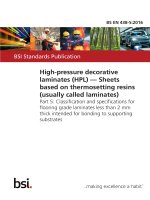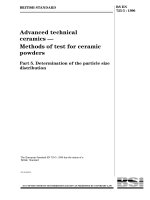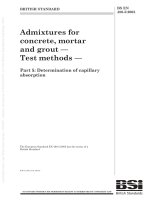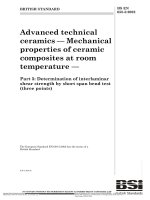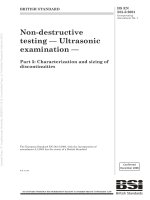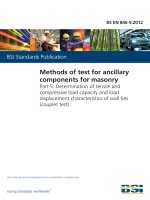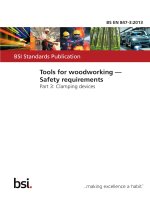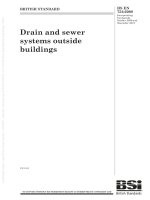Bsi bs en 61788 5 2013
Bạn đang xem bản rút gọn của tài liệu. Xem và tải ngay bản đầy đủ của tài liệu tại đây (1.29 MB, 30 trang )
BS EN 61788-5:2013
BSI Standards Publication
Superconductivity
Part 5: Matrix to superconductor volume
ratio measurement — Copper to
superconductor volume ratio of
Cu/Nb-Ti composite superconducting
wires
BRITISH STANDARD
BS EN 61788-5:2013
National foreword
This British Standard is the UK implementation of EN 61788-5:2013. It
is identical to IEC 61788-5:2013. It supersedes BS EN 61788-5:2001
which is withdrawn.
The UK participation in its preparation was entrusted to Technical
Committee L/-/90, Super Conductivity.
A list of organizations represented on this committee can be obtained on
request to its secretary.
This publication does not purport to include all the necessary provisions of
a contract. Users are responsible for its correct application.
© The British Standards Institution 2013.
Published by BSI Standards Limited 2013
ISBN 978 0 580 75668 9
ICS 17.220.20; 29.050
Compliance with a British Standard cannot confer immunity from
legal obligations.
This British Standard was published under the authority of the
Standards Policy and Strategy Committee on 30 September 2013.
Amendments/corrigenda issued since publication
Date
Text affected
BS EN 61788-5:2013
EUROPEAN STANDARD
EN 61788-5
NORME EUROPÉENNE
September 2013
EUROPÄISCHE NORM
ICS 17.220.20; 29.050
Supersedes EN 61788-5:2001
English version
Superconductivity Part 5: Matrix to superconductor volume ratio measurement Copper to superconductor volume ratio of Cu/Nb-Ti composite
superconducting wires
(IEC 61788-5:2013)
Supraconductivité Partie 5 : Mesure du rapport volumique
matrice/supraconducteur Rapport volumique
cuivre/supraconducteur des fils en
composite supraconducteur Cu/Nb-Ti
(CEI 61788-5:2013)
Supraleitfähigkeit Teil 5: Messung des Verhältnisses von
Matrixvolumen zu Supraleitervolumen Verhältnis von Kupfervolumen zu
Supraleitervolumen von Cu/Nb-Ti
Verbundsupraleiterdrähten
(IEC 61788-5:2013)
This European Standard was approved by CENELEC on 2013-07-02. CENELEC members are bound to comply
with the CEN/CENELEC Internal Regulations which stipulate the conditions for giving this European Standard
the status of a national standard without any alteration.
Up-to-date lists and bibliographical references concerning such national standards may be obtained on
application to the CEN-CENELEC Management Centre or to any CENELEC member.
This European Standard exists in three official versions (English, French, German). A version in any other
language made by translation under the responsibility of a CENELEC member into its own language and notified
to the CEN-CENELEC Management Centre has the same status as the official versions.
CENELEC members are the national electrotechnical committees of Austria, Belgium, Bulgaria, Croatia, Cyprus,
the Czech Republic, Denmark, Estonia, Finland, Former Yugoslav Republic of Macedonia, France, Germany,
Greece, Hungary, Iceland, Ireland, Italy, Latvia, Lithuania, Luxembourg, Malta, the Netherlands, Norway, Poland,
Portugal, Romania, Slovakia, Slovenia, Spain, Sweden, Switzerland, Turkey and the United Kingdom.
CENELEC
European Committee for Electrotechnical Standardization
Comité Européen de Normalisation Electrotechnique
Europäisches Komitee für Elektrotechnische Normung
CEN-CENELEC Management Centre: Avenue Marnix 17, B - 1000 Brussels
© 2013 CENELEC -
All rights of exploitation in any form and by any means reserved worldwide for CENELEC members.
Ref. No. EN 61788-5:2013 E
BS EN 61788-5:2013
EN 61788-5:2013
-2-
Foreword
The text of document 90/321/FDIS, future edition 2 of IEC 61788-5, prepared by IEC/TC 90
"Superconductivity" was submitted to the IEC-CENELEC parallel vote and approved by CENELEC as
EN 61788-5:2013.
The following dates are fixed:
•
latest date by which the document has to be
implemented at national level by
publication of an identical national
standard or by endorsement
(dop)
2014-04-02
•
latest date by which the national
standards conflicting with the
document have to be withdrawn
(dow)
2016-07-02
This document supersedes EN 61788-5:2001.
EN 61788-5:2013 includes
EN 61788-5:2001:
the
following
significant
technical
changes
with
respect
to
The main revisions are the addition of two new annexes, "Uncertainty considerations" (Annex E) and
"Uncertainty evaluation in test method of copper to superconductor volume ratio of Cu/Nb-Ti
composite superconductors" (Annex F).
Attention is drawn to the possibility that some of the elements of this document may be the subject of
patent rights. CENELEC [and/or CEN] shall not be held responsible for identifying any or all such
patent rights.
Endorsement notice
The text of the International Standard IEC 61788-5:2013 was approved by CENELEC as a European
Standard without any modification.
BS EN 61788-5:2013
EN 61788-5:2013
-3-
Annex ZA
(normative)
Normative references to international publications
with their corresponding European publications
The following documents, in whole or in part, are normatively referenced in this document and are
indispensable for its application. For dated references, only the edition cited applies. For undated
references, the latest edition of the referenced document (including any amendments) applies.
NOTE When an international publication has been modified by common modifications, indicated by (mod), the relevant EN/HD
applies.
Publication
Year
Title
IEC 60050-815
Series International Electrotechnical Vocabulary
(IEV)
EN/HD
Year
-
-
–2–
BS EN 61788-5:2013
61788-5 © IEC:2013
CONTENTS
INTRODUCTION ..................................................................................................................... 5
1
Scope ............................................................................................................................... 6
2
Normative references ....................................................................................................... 6
3
Terms and definitions ....................................................................................................... 6
4
Principle ........................................................................................................................... 7
5
Chemicals ........................................................................................................................ 7
6
Apparatus ......................................................................................................................... 7
7
Measurement procedure ................................................................................................... 8
8
7.1 Quantity of specimen ............................................................................................... 8
7.2 Removal of insulating cover material ....................................................................... 8
7.3 Cleaning .................................................................................................................. 8
7.4 Drying ..................................................................................................................... 8
7.5 Measurement of specimen mass and its repetition ................................................... 8
7.6 Dissolving copper .................................................................................................... 8
7.7 Cleaning and drying the Nb-Ti filaments .................................................................. 9
7.8 Measurement of dissolved specimen mass and its repetition ................................... 9
7.9 Procedural repetition for second specimen ............................................................ 10
Calculation of results ...................................................................................................... 10
9
Uncertainty of the test method ........................................................................................ 10
10 Test report ...................................................................................................................... 11
10.1
10.2
10.3
Annex A
Identification of test specimen ............................................................................... 11
Report of copper to superconductor volume ratio ................................................... 11
Report of test conditions ........................................................................................ 11
(normative) Copper to superconductor volume ratio – copper mass method .......... 12
Annex B (informative)
Specific mass depending on Nb-Ti fraction ....................................... 14
Annex C (information)
Mechanical removal of insulating cover materials ............................ 15
Annex D (informative)
Second etch of specimen ................................................................. 16
Annex E (informative)
Uncertainty considerations ............................................................... 17
Annex F (informative) Uncertainty evaluation in the test method of copper to
superconductor volume ratio of Cu/Nb-Ti composite superconductors ................................... 22
Table B.1 – Specific mass of Nb-Ti ....................................................................................... 14
Table E.1 – Output signals from two nominally identical extensometers ................................ 18
Table E.2 – Mean values of two output signals ..................................................................... 18
Table E.3 – Experimental standard deviations of two output signals ...................................... 18
Table E.4 – Standard uncertainties of two output signals ...................................................... 19
Table E.5 – Coefficient of variations of two output signals ..................................................... 19
BS EN 61788-5:2013
61788-5 © IEC:2013
–5–
INTRODUCTION
The copper to superconductor volume ratio of composite superconductors is used mainly to
calculate the critical current density of superconducting wires. The test with the method given
in this International Standard may be used to provide part of the information needed to
determine the suitability of a specific superconductor. Moreover, this method is useful for
quality control, acceptance or research testing if the precautions given in this standard are
observed.
The test method given in this International Standard is based on the condition that the specific
mass of Nb-Ti is known or the Nb-Ti alloy fraction is known and Annex B can be used to estimate
the specific mass. If the specific mass of Nb-Ti is unknown and the Nb-Ti alloy fraction is
unknown and/or the fraction of Nb barrier is unknown, another method to determine the copper
to superconductor volume ratio of composite superconductors is described in Annex A.
–6–
BS EN 61788-5:2013
61788-5 © IEC:2013
SUPERCONDUCTIVITY –
Part 5: Matrix to superconductor volume ratio measurement –
Copper to superconductor volume ratio of Cu/Nb-Ti composite
superconducting wires
1
Scope
This part of IEC 61788 covers a test method for the determination of copper to superconductor
volume ratio of Cu/Nb-Ti composite superconducting wires.
This test method and the alternate method in Annex A are intended for use with Cu/Nb-Ti
composite superconducting wires with a cross-sectional area of 0,1 mm 2 to 3 mm 2 , a diameter
of the Nb-Ti filament(s) of 2 µm to 200 µm, and a copper to superconductor volume ratio of 0,5
or more.
The Cu/Nb-Ti composite test conductor discussed in this method has a monolithic structure
with a round or rectangular cross-section. This test method is carried out by dissolving the
copper with nitric acid. Deviations from this test method that are allowed for routine tests and
other specific restrictions are given in this standard.
Cu/Nb-Ti composite superconducting wires beyond the limits in the cross-sectional area, the
filament diameter and the copper to superconductor volume ratio could be measured with this
present method with an anticipated reduction of uncertainty. Other, more specialized,
specimen test geometries may be more appropriate for conductors beyond the limits and have
been omitted from this present standard for simplicity and to retain low uncertainty.
The test method given in this standard is expected to apply to other superconducting composite
wires after some appropriate modifications.
2
Normative references
The following documents, in whole or in part, are normatively referenced in this document and
are indispensable for its application. For dated references, only the edition cited applies. For
undated references, the latest edition of the referenced document (including any amendments)
applies.
IEC 60050-815 (all parts), International
<>)
3
Electrotechnical
Vocabulary
(available
at
Terms and definitions
For the purposes of this document, the definitions given in IEC 60050-815 as well as the
following definition apply.
3.1
copper to superconductor volume ratio
ratio of the volume of the copper stabilizing material to the volume without copper consisting of
Nb-Ti filaments and their Nb barriers
BS EN 61788-5:2013
61788-5 © IEC:2013
4
–7–
Principle
The test method utilizes the nature of the Cu/Nb-Ti composite superconducting wire whereby
the copper dissolves in nitric acid solution but the Nb-Ti filaments and Nb barriers do not.
After measuring its mass, dip the specimen into the nitric acid solution to dissolve only the
copper.
Then measure the mass of the remaining Nb-Ti filaments and their Nb barriers.
The volume and mass of the starting wire and the mass of the filaments are used to determine
the copper to superconductor volume ratio.
5
Chemicals
The following chemicals shall be prepared for sample preparation:
a) nitric acid solution consisting of nitric acid (a volume fraction of 50 % to 65 % recommended)
and distilled water;
b) organic solvent;
c) degreasing solvent;
d) ethyl alcohol;
e) distilled (pure) water.
NOTE When nitric acid of more than a mass fraction of 65 % is used, the acid is diluted with distilled water within
the range of the above content.
6
Apparatus
The following apparatus shall be prepared.
•
Draft chamber
•
Balance
A balance shall have a manufacturer’s specified uncertainty of ±0,1 mg or better.
•
Dryer or drying oven
A dryer or a drying oven shall be used for evaporating moisture after washing the specimen.
•
Beaker
•
Watch-glass
•
Plastic tweezers
•
Filter papers
•
Thermometer
•
Rubber gloves and protection spectacles
Rubber gloves and protection spectacles shall be used for protecting the human body from the
harmful acid liquid or fumes. The dissolution of the specimen shall be performed in a draft
chamber in order to protect the human body.
–8–
7
7.1
BS EN 61788-5:2013
61788-5 © IEC:2013
Measurement procedure
Quantity of specimen
Take a specimen of around 1 g to 10 g in mass from the base test material.
7.2
Removal of insulating cover material
An appropriate organic solvent, which does not erode the copper, shall be used to remove any
insulating cover material of the specimen. Finally, it shall be visually checked that the insulating
cover material no longer remains.
If no organic solvents can remove the insulating cover material, the mechanical removal in
Annex C is an alternative.
7.3
Cleaning
A degreaser shall be used to remove oil and/or grease traces from the specimen, whose cover
material has been removed. It shall then be cleaned with pure water. Finally, the degreased
specimen shall be dipped into ethyl alcohol to replace the water. Cleaning without using ethyl
alcohol is an alternative, by using the drying process described in 7.4.
7.4
Drying
The clean specimen shall be placed on a watch-glass and dried fully in a dryer or a drying oven
at a temperature of 60 °C or lower with the holding time more than 0,5 hours. When cleaning
the specimen is carried out without ethyl alcohol, the specimen shall be dried fully in a dryer or
a drying oven at a temperature of 100 °C with the holding time more than 0,5 hours.
7.5
Measurement of specimen mass and its repetition
When the specimen is cooled down to 35 °C or lower, its mass shall be measured on a sheet of
weighing paper, using a balance with a manufacturer’s specified uncertainty of ±0,1 mg or
better.
After completion of this mass measurement (the first measurement), remove the specimen from
the balance.
To assure that the specimen has been fully dried, the mass of the specimen shall be measured
again about 10 min after the first measurement (the second measurement).
The difference in mass between the first and second measurements shall be within ±0,5 %. If
this difference is within ±0,5 %, the average of the two measurements shall be regarded as the
mass of the specimen.
If the difference in mass is more than ±0,5 %, cleaning of the specimen with ethyl alcohol and
drying of the specimen shall be repeated as described in 7.3, 7.4 and 7.5 until the difference in
mass of the two measurements is within ±0,5 %.
As soon as this part of the method is qualified by a successful repetition, the second mass
measurement can be omitted in subsequent measurements. However, periodic re-qualification
shall be performed every six months or after changes of equipment or personnel.
7.6
Dissolving copper
The copper shall be dissolved from the specimen in the following manner.
BS EN 61788-5:2013
61788-5 © IEC:2013
–9–
Put approximately 150 ml of the nitric acid solution in a 300 ml beaker. Tie a knot in the
specimen to help retain all of the filaments upon completion of the etch. In the draft chamber,
while maintaining the temperature of the nitric acid solution between 20 °C and 50 °C, the
whole specimen shall be dipped into the nitric acid solution for 30 min to 1 h to completely
dissolve the copper of the specimen. It shall be checked visually that the copper has been
completely dissolved. For wires with filaments less than 10 µm, the second etch according to
Annex D is recommended to assure a complete copper dissolution.
Note that a fresh nitric acid solution shall be used for each specimen that is etched.
When copper is dissolved in the nitric acid solution, nitrite gas is generated. Because the nitric
acid and the nitrite gas are harmful to the human body, use all safety precautions in handling
acids such as wearing protective clothing and carrying out work to dissolve the copper in the
draft chamber. In addition, the fumes generated during storage and use are harmful. Normal
safety precautions for acid storage, use and disposal shall be followed.
Use rubber gloves, protection spectacles and a pair of plastic tweezers during the treatment of
the nitric acid solution.
NOTE The temperature of the nitric acid solution specified here is that before dipping the specimen in it. The
temperature can rise to more than 50 °C when dissolution of the copper is in progress.
When mixing the solution, always add the nitric acid to the water.
7.7
Cleaning and drying the Nb-Ti filaments
Cleaning and drying the Nb-Ti filaments shall be performed in the following manner.
Acid shall be carefully poured out of the beaker into a plastic sewage reservoir, keeping the
specimen in the beaker so as not to lose any broken filaments. The beaker shall be refilled with
distilled water to rinse. The water shall be carefully poured out of the beaker. The beaker shall
now be refilled, with ethyl alcohol this time to replace any remaining water. Now to dry all of the
filaments fully, the specimen shall be placed, using plastic tweezers, on a sheet of filter paper
with any broken or loose filaments. They shall then be placed in a dryer or a drying oven
(see 7.4).
If a green stain is noticed on the filter paper, then there is acid remaining on the filaments. This
acid shall be removed by rinsing again in alcohol.
Cleaning without using ethyl alcohol is an alternative, by using the drying process described
in 7.4.
If there are too many broken filaments, the procedures shall be repeated from the beginning on
a new specimen.
Nb-Ti filaments with a diameter of about 10 µm or less can be combustible when they are
removed from the acid and exposed to air after the matrix has been removed. Ignition sources
(including flame, heat, spark and electrostatic discharge) are avoided. In addition, tweezers
shall be used to handle the etched filaments and they shall not be put in contact with any part of
the body. Normal safety precautions for metal combustion hazards shall be followed.
7.8
Measurement of dissolved specimen mass and its repetition
When the specimen is cooled down to 35 °C or lower, using a balance with a manufacturer’s
specified uncertainty of ±0,1 mg or better, the specimen shall be weighed as in 7.5. A sheet of
weighing paper shall be used for the measurement to avoid losing broken filaments (the first
measurement).
BS EN 61788-5:2013
61788-5 © IEC:2013
– 10 –
After completion of the mass measurement described in 7.5, the Nb-Ti filaments shall be
removed from the balance. To know whether the Nb-Ti filaments have been fully dried, the
mass of the Nb-Ti filaments shall be weighed again about 10 min after the first measurement
(the second measurement).
The difference in mass shall be within ±0,5 % between the second measurement and the first
measurement. If the difference in mass is within ±0,5 % between the two measurements, the
average of the masses of the two measurements shall be regarded as the mass of the
filaments.
If the difference in mass of the two measurements is more than ±0,5 %, only cleaning with ethyl
alcohol and drying shall be repeated as described in the procedural step of 7.7, and then
procedural steps shall be repeated again in the procedural step of 7.5. Then, check again to
make sure that the difference in mass of the two measurements is within ±0,5 %.
As soon as this part of the method is qualified by a successful repetition, the second mass
measurement can be omitted in subsequent measurements. However, periodic re-qualification
shall be performed every six months or after changes in equipment or personnel.
7.9
Procedural repetition for second specimen
The procedural steps in 7.1 through 7.8 shall be repeated on the second specimen.
As soon as the method is qualified by a successful repetition, the repeated measurements on
the second specimen can be omitted in subsequent measurements. However, periodic
re-qualification shall be performed every six months or after changes in equipment or
personnel.
8
Calculation of results
For each measurement, the copper to superconductor volume ratio shall be obtained down to
two decimal places in the following equation, by rounding off to two decimal places.
If two specimens are measured, the average of the two ratios shall be regarded as the copper to
superconductor volume ratio.
Copper to superconductor volume ratio is expressed as (M W − MNb− Ti ) × ρNb− Ti ,
MNb− Ti × ρCu
where
MW
is the mass of the specimen g;
M Nb-Ti is the mass of the Nb-Ti filaments g;
ρ Cu
is 8,93, which is the specific mass of copper g/cm 3 ;
ρ Nb-Ti is the specific mass of the Nb-Ti filament g/cm 3 .
The specific mass of the Nb-Ti alloy can be obtained by interpolation of the values given in
Annex B if it is not given by the wire manufacturer.
NOTE If a barrier such as Nb is used, it is included in the mass of the Nb-Ti filament by calculating an effective
filament specific mass taking into consideration the fraction of Nb barrier.
9
Uncertainty of the test method
The advantage of the method is that the copper to superconductor volume ratio can be
obtained only from the masses of the specimen and Nb-Ti filaments. Since masses can be
BS EN 61788-5:2013
61788-5 © IEC:2013
– 11 –
measured fairly accurately, the masses can be determined with a relative combined standard
uncertainty of less than 0,05 % even for a specimen with a mass of 1 g and a copper to
superconductor volume ratio of 10.
Uncertainty is also affected by the specific mass of Nb-Ti. The first option shall be to use the
value of the specific mass of Nb-Ti given by the wire manufacturer because it depends on more
than the alloy composition (see NOTE 1 in Annex B).Otherwise, the value of the specific mass of
Nb-Ti alloy shall be determined within a relative standard uncertainty of 0,5 % by interpolation of
the values listed in Annex B .
If a barrier such as Nb is used, it shall be included in the mass of the Nb-Ti filament by
calculating an effective filament specific mass taking into consideration the fraction of Nb barrier
to retain low uncertainty.
If the specific mass of Nb-Ti is unknown and the Nb-Ti alloy fraction is unknown and/or the
fraction of Nb barrier is unknown, then use the method in Annex A.
The target relative combined standard uncertainty of this test method shall not exceed 2 %
(using a coverage factor of k = 1), which is confirmed in the relative combined standard
uncertainty of 0,06 % for the copper dissolving method, and 0,2 % for the copper mass method
according to round robin tests made to establish this standard as shown in Annex F .
10 Test report
10.1
Identification of test specimen
The test specimen shall be identified, if possible, by the following information:
a) manufacturer name of the specimen;
b) identification number;
c) billet number;
d) raw material composition;
e) shape and area of the cross-section of the wire, number of filaments, diameter of filaments,
and Nb barrier.
10.2
Report of copper to superconductor volume ratio
The test report shall contain the following information:
a) the copper to superconductor volume ratio of each specimen;
b) Nb-Ti specific mass value used;
c) method of removing insulation from the specimen, if any.
10.3
Report of test conditions
The following test conditions shall be reported:
a) ambient temperature;
b) nitric acid temperature at the beginning;
c) nitric acid immersion time duration;
d) drying time duration.
– 12 –
BS EN 61788-5:2013
61788-5 © IEC:2013
Annex A
(normative)
Copper to superconductor volume ratio – copper mass method
A.1
General
If the specific mass of Nb-Ti is unknown and the Nb-Ti alloy fraction is unknown and/or the
fraction of Nb barrier is unknown, then the copper to superconductor volume ratio shall be
measured in the following manner. Clauses 1 to 6 also apply to this annex.
A.2
Quantity of specimen
A specimen of around 50 cm long and not exceeding the mass of 10 g shall be taken out of the
base test material.
A.3
Remove insulation, cleaning, and drying
Refer to subclauses 7.2 to 7.4.
A.4
Measurement of specimen length
The length (L), in centimetres, of the specimen shall be measured with a relative combined
standard uncertainty not to exceed 0,1 %.
A.5
Measurement of specimen diameter
The diameter (if it is a round wire) or two sides (if it is a rectangular wire) of the specimen shall
be measured for the cross-sectional area measurement at five points along its length with
combined standard uncertainty not to exceed 0,5 µm. Then the average cross-sectional area
(A), in square centimetres, shall be calculated from those values obtained at the five points.
A.6
Measurement of specimen mass
The mass (MW ), in grams, of the specimen shall be measured on a balance with a
manufacturer’s specified uncertainty of ±0,1 mg or better.
A.7
Dissolving copper and measurement of dissolved specimen mass
The copper shall be measured in the same manner as in 7.6 and the cleaning and drying of the
dissolved specimen shall be performed in the same manner as in 7.7 .
The mass (M Nb-Ti ), in grams, of the filaments shall be determined in the same manner as
Clause 7.8 of the main method.
A.8
Procedural repetition for the second specimen
The procedural steps in Clauses A.1 through A.6 shall be repeated on the second specimen. As
soon as the method is qualified by a successful repetition, the repeated measurements on the
BS EN 61788-5:2013
61788-5 © IEC:2013
– 13 –
second specimen can be omitted in subsequent measurements. However, periodic
re-qualification shall be performed every six months or after changes of equipment or personnel.
A.9
Calculation
Assuming the specific mass of the copper ( ρCu ) 8,93 g/cm 3 , the copper to superconductor
volume ratio of Cu/Nb-Ti composite superconducting wires with copper mass method (R Cu , m )
shall be obtained using the following equation.
RCu,m =
(M W − MNb−Ti ) / ρCu
A × L − (M W − MNb−Ti ) / ρCu
(A.1)
NOTE 1 There may be large errors for the measurement of thin round wire and thin rectangular wire. So, care is
taken for the measurement of those wires.
NOTE 2 For rectangular wire, the cross-sectional area (A), in square centimetres, is corrected according to the
radius at the corners of the cross-sectional area, which is given in the specifications supplied by the manufacturers.
In the case of rectangular wire, the uncertainty of the method in Annex A becomes worse if correction according to the
radius at the corners is not taken into account.
BS EN 61788-5:2013
61788-5 © IEC:2013
– 14 –
Annex B
(informative)
Specific mass depending on Nb-Ti fraction
Specific mass depending on Nb-Ti fraction is summarised in Table B.1.
Table B.1 – Specific mass of Nb-Ti
Nb-Ti fraction
-mass %-
Nb-Ti fraction
- volume %-
Specific mass
g/cm 3
Nb
Nb
8,57
Nb – 43,2 mass % Ti
Nb – 59,1 volume % Ti
6,16
Nb – 45,0 mass % Ti
Nb – 60,9 volume % Ti
6,09
Nb – 46,5 mass % Ti
Nb – 62,3 volume % Ti
6,04
Nb – 47,0 mass % Ti
Nb – 62,8 volume % Ti
6,02
Nb – 48,0 mass % Ti
Nb – 63,7 volume % Ti
5,98
Nb – 53,5 mass % Ti
Nb – 68,6 volume % Ti
5,76
Nb – 55,0 mass % Ti
Nb – 69,9 volume % Ti
5,70
Ti
Ti
4,51
NOTE 1 The specific mass of the Nb-Ti alloy depends not only on its composition but
also on other parameters: amount of cold work, impurities, phase condition, and so
on.
NOTE 2 Relative standard uncertainty of 0,5 %. Additional digits are provided for
more precise interpolation using volume % Ti. Consider adding conversion from mass
fraction to volume fraction: f v = (f m/4,51)/f m/4,51 + (1-f m )/8,57, where f v is the volume
fraction of Ti and f m is the mass fraction of Ti.
BS EN 61788-5:2013
61788-5 © IEC:2013
– 15 –
Annex C
(information)
Mechanical removal of insulating cover materials
Specimens covered with insulating material such as polyimide tape, which cannot be removed
with a solvent, are outside the scope of this standard. It is likely that some errors may be
caused in the measurement when the insulating material is mechanically removed.
– 16 –
BS EN 61788-5:2013
61788-5 © IEC:2013
Annex D
(informative)
Second etch of specimen
It is recommended that etching be repeated to ensure the complete dissolution of copper,
especially for fine filament wires. After the mass measurement of the dissolved specimen, the
second etch and mass measurements are carried out according to 7.6 to 7.9. Check to ensure
that the difference in mass for the two measurements is within ±0,5 %.
BS EN 61788-5:2013
61788-5 © IEC:2013
– 17 –
Annex E
(informative)
Uncertainty considerations
E.1
Overview
In 1995, a number of international standards organizations, including IEC, decided to unify the
use of statistical terms in their standards. It was decided to use the word “uncertainty” for all
quantitative (associated with a number) statistical expressions and eliminate the quantitative
use of “precision” and “accuracy.” The words “accuracy” and “precision” could still be used
qualitatively. The terminology and methods of uncertainty evaluation are standardized in the
Guide to the Expression of Uncertainty in Measurement (GUM) [1] 1.
It was left to each TC to decide if they were going to change existing and future standards to be
consistent with the new unified approach. Such change is not easy and creates additional
confusion, especially for those who are not familiar with statistics and the term uncertainty. At
the June 2006 TC 90 meeting in Kyoto, it was decided to implement these changes in future
standards.
Converting “accuracy” and “precision” numbers to the equivalent “uncertainty” numbers requires
knowledge about the origins of the numbers. The coverage factor of the original number may
have been 1, 2, 3, or some other number. A manufacturer’s specification that can sometimes be
described by a rectangular distribution will lead to a conversion number of 1/√3. The appropriate
coverage factor was used when converting the original number to the equivalent standard
uncertainty. The conversion process is not something that the user of the standard needs to
address for compliance to TC 90 standards, it is only explained here to inform the user about
how the numbers were changed in this process. The process of converting to uncertainty
terminology does not alter the user’s need to evaluate their measurement uncertainty to
determine if the criteria of the standard are met.
The procedures outlined in TC 90 measurement standards were designed to limit the
uncertainty of any quantity that could influence the measurement, based on the Convener’s
engineering judgment and propagation of error analysis. Where possible, the standards have
simple limits for the influence of some quantities so that the user is not required to evaluate the
uncertainty of such quantities. The overall uncertainty of a standard was then confirmed by an
interlaboratory comparison.
E.2
Definitions
Statistical definitions can be found in three sources: the GUM, the International Vocabulary of
Basic and General Terms in Metrology (VIM)[2], and the NIST Guidelines for Evaluating and
Expressing the Uncertainty of NIST Measurement Results (NIST)[3]. Not all statistical terms
used in this standard are explicitly defined in the GUM. For example, the terms “relative standard
uncertainty” and “relative combined standard uncertainty” are used in the GUM (5.1.6, Annex J),
but they are not formally defined in the GUM (see [3]).
E.3
Consideration of the uncertainty concept
Statistical evaluations in the past frequently used the coefficient of variation (COV) which is the
ratio of the standard deviation and the mean (N.B. the COV is often called the relative standard
deviation). Such evaluations have been used to assess the precision of the measurements and
___________
1
Figures in square brackets refer to the reference documents in Clause E.5 of this Annex.
BS EN 61788-5:2013
61788-5 © IEC:2013
– 18 –
give the closeness of repeated tests. The standard uncertainty (SU) depends more on the
number of repeated tests and less on the mean than the COV and therefore in some cases gives
a more realistic picture of the data scatter and test judgment. The example below shows a set of
electronic drift and creep voltage measurements from two nominally identical extensometers
using the same signal conditioner and data acquisition system. The n = 10 data pairs are taken
randomly from the spreadsheet of 32 000 cells. Here, extensometer number one (E 1 ) is at zero
offset position whilst extensometer number two (E 2 ) is deflected to 1 mm. The output signals are
in volts.
Table E.1 – Output signals from two nominally identical extensometers
Output signal
V
E1
E2
0,001 220 70
2,334 594 73
0,000 610 35
2,334 289 55
0,001 525 88
2,334 289 55
0,001 220 70
2,334 594 73
0,001 525 88
2,334 594 73
0,001 220 70
2,333 984 38
0,001 525 88
2,334 289 55
0,000 915 53
2,334 289 55
0,000 915 53
2,334 594 73
0,001 220 70
2,334 594 73
Table E.2 – Mean values of two output signals
Mean (
V
X)
E1
E2
0,001 190 19
2,334 411 62
n
∑ Xi
X = i =1
n
[V ]
(E.1)
Table E.3 – Experimental standard deviations of two output signals
Experimental standard deviation (s)
V
E1
E2
0,000 303 48
0,000 213 381
s=
n
2
1
⋅
Xi − X
n − 1 i =1
∑(
)
[V ]
(E.2)
BS EN 61788-5:2013
61788-5 © IEC:2013
– 19 –
Table E.4 – Standard uncertainties of two output signals
Standard uncertainty (u)
V
E1
E2
0,000 095 97
0,000 067 48
u=
s
n
[V ]
(E.3)
Table E.5 – Coefficient of variations of two output signals
Coefficient of Variation (COV)
%
E1
E2
25,4982
0,0091
COV =
s
X
(E.4)
The standard uncertainty is very similar for the two extensometer deflections. In contrast the
coefficient of variation COV is nearly a factor of 2 800 different between the two data sets. This
shows the advantage of using the standard uncertainty which is independent of the mean value.
E.4
Uncertainty evaluation example for TC 90 standards
The observed value of a measurement does not usually coincide with the true value of the
measurand. The observed value may be considered as an estimate of the true value. The
uncertainty is part of the "measurement error" which is an intrinsic part of any measurement. The
magnitude of the uncertainty is both a measure of the metrological quality of the measurements
and improves the knowledge about the measurement procedure. The result of any physical
measurement consists of two parts: an estimate of the true value of the measurand and the
uncertainty of this “best” estimate. The GUM, within this context, is a guide for a transparent,
standardized documentation of the measurement procedure. One can attempt to measure the
true value by measuring “the best estimate” and using uncertainty evaluations which can be
considered as two types: Type A uncertainties (repeated measurements in the laboratory in
general expressed in the form of Gaussian distributions) and Type B uncertainties (previous
experiments, literature data, manufacturer’s information, etc. often provided in the form of
rectangular distributions).
The calculation of uncertainty using the GUM procedure is illustrated in the following example:
a) The user must derive in the first step a mathematical measurement model in the form of
identified measurand as a function of all input quantities. A simple example of such model
is given for the uncertainty of a force, F LC measurement using a load cell:
F LC = W + d w + d R + d Re
where W, d w , d R , and d Re represent the weight of standard as expected, the manufacturer’s
data, repeated checks of standard weight/day and the reproducibility of checks at different
days, respectively.
Here the input quantities are: the measured weight of standard weights using different
balances (Type A), manufacturer’s data (Type B), repeated test results using the digital
electronic system (Type B), and reproducibility of the final values measured on different days
(Type B).
– 20 –
BS EN 61788-5:2013
61788-5 © IEC:2013
b) The user should identify the type of distribution for each input quantity (e.g. Gaussian
distributions for Type A measurements and rectangular distributions for Type B
measurements).
c) Evaluate the standard uncertainty of the Type A measurements,
uA =
s
where, s is the experimental standard deviation and n is the total number of
n
measured data points.
d) Evaluate the standard uncertainties of the Type B measurements:
uB =
1
⋅ d w 2 + .......
3
where, d w is the range of rectangular distributed values
e) Calculate the combined standard uncertainty for the measurand by combining all the
standard uncertainties using the expression:
uc = u A2 + uB2
In this case, it has been assumed that there is no correlation between input quantities. If the
model equation has terms with products or quotients, the combined standard uncertainty is
evaluated using partial derivatives and the relationship becomes more complex due to the
sensitivity coefficients [4], [5].
f)
Optional – the combined standard uncertainty of the estimate of the referred measurand can
be multiplied by a coverage factor (e. g. 1 for 68 % or 2 for 95 % or 3 for 99 %) to increase the
probability that the measurand can be expected to lie within the interval.
g) Report the result as the estimate of the measurand ± the expanded uncertainty, together with
the unit of measurement, and, at a minimum, state the coverage factor used to compute the
expanded uncertainty and the estimated coverage probability.
To facilitate the computation and standardize the procedure, use of appropriate certified
commercial software is a straightforward method that reduces the amount of routine work [6], [7].
In particular, the indicated partial derivatives can be easily obtained when such a software tool
is used. Further references for the guidelines of measurement uncertainties are given in [3], [8],
and [9].
E.5
Reference documents of Annex E
[1]
ISO/IEC Guide 98-3:2008, Uncertainty of measurement – Part 3: Guide to the expression
of uncertainty in measurement (GUM 1995)
[2]
ISO/IEC Guide 99:2007, International vocabulary of metrology – Basic and general
concepts and associated terms (VIM)
[3]
TAYLOR, B.N. and KUYATT, C.E. Guidelines for Evaluating and Expressing the
Uncertainty of NIST Measurement Results. NIST Technical Note 1297, 1994 (Available at
< />
[4]
KRAGTEN, J. Calculating standard deviations and confidence intervals with a universally
applicable spreadsheet technique Analyst, (1994), 119, 2161-2166
[5]
EURACHEM / CITAC Guide CG 4 Second edition:2000, Quantifying Uncertainty in
Analytical Measurement
[6]
[Cited 2013-02-18] Available at < />
[7]
[Cited 2013-02-18] Available at < />
[8]
CHURCHILL, E., HARRY, H.K., and COLLE,R., Expression of the Uncertainties of Final
Measurement Results. NBS Special Publication 644 (1983)
BS EN 61788-5:2013
61788-5 © IEC:2013
[9]
– 21 –
JAB NOTE Edition 1:2003, Estimation of Measurement Uncertainty (Electrical Testing /
High Power Testing). (Available at <>).
– 22 –
BS EN 61788-5:2013
61788-5 © IEC:2013
Annex F
(informative)
Uncertainty evaluation in the test method of copper to superconductor
volume ratio of Cu/Nb-Ti composite superconductors
F.1
Copper dissolving method
F.1.1
Mathematical model
The copper to superconductor volume ratio of Cu/Nb-Ti composite superconductors measured
with the copper dissolving method (R Cu,d ) is formally given by Equation (F.1),
RCu,d
M W M Nb Ti Nb Ti
M Nb Ti Cu
(F.1)
where
MW
is the mass of the specimen g;
M Nb-Ti
is the mass of the Nb-Ti filaments g;
Cu
is 8,93, which is the specific mass of copper g/cm 3 ;
Nb-Ti
is the specific mass of the Nb-Ti filament g/cm 3 .
F.1.2
Evaluation of sensitivity coefficients
The combined standard uncertainty of the copper to superconductor volume ratio of Cu/Nb-Ti
composite superconductors with the copper dissolving method is formally given by Equation
(F.2),
uRCuc,d c12uMWc 2 c2 2uMNb Tic 2 c3 2u Nb Tic 2 c4 2u Cu 2
(F.2)
where
u RCuc,d
is a combined standard uncertainty of copper to superconductor volume ratio with the
copper dissolving method;
u MWc
is a combined standard uncertainty of the specimen with the copper dissolving
method;
MW
is given by 5,00 g;
u MNb-Tic
is a combined standard uncertainty of Nb-Ti mass with the copper dissolving method;
M Nb-Ti
is given by 1,00 g;
Nb-Ti
is a specific mass of the Nb-Ti filament, given by 6,04;
cn
means the sensitivity coefficient for each variable, which is the partial differential term
of the Equation (F.1),
M W
M w
0,676 1/ g
Nb Ti
M Nb Ti 2
ρ
M Nb Ti
M Nb Ti Cu
ρ
RCu, d
Nb Ti
ρ
c2
RCu,d
ρ
c1
Cu
3,382 1 / g
BS EN 61788-5:2013
61788-5 © IEC:2013
Cu
M W
M Nb Ti
M Nb Ti
ρ
M w M Nb Ti
0,448 cm3 / g
M Nb Ti Cu
Cu
ρ
RCu, d
ρ
Nb Ti
ρ
c4
RCu,d
ρ
c3
– 23 –
Nb Ti
2
0,303 cm 3 / g
Quantities used in this evaluation of sensitivity coefficients only apply to a specific experimental
case. These coefficients are not universally applicable and will be different for each experiment.
F.1.3
Combined standard uncertainty of each variable
The following results were obtained using the sensitivity coefficients from F.1.2.
a) Combined standard uncertainty of sample mass, u MWc = 0,004 g, which is composed of
experimental standard uncertainty of M W , 0,002 g and the type B uncertainty of the
balance, 0,003 g (5,00 g × 0,001/√3).
b) Combined standard uncertainty of Nb-Ti mass, u MNb-Tic = 0,0008 g, which is composed
of experimental standard uncertainty of 0,0006 g and the type B uncertainty of the
balance of 0,0006 g.
c) Standard uncertainty of a specific mass of the Nb-Ti filament, u Nb-Ti = 0,0070 g/cm 3 ,
which is assumed by the type B uncertainty of the Nb-Ti filament with Nb barrier, 0,2 %.
d) Standard uncertainty of the specific mass of copper, u Cu = 0,0052 g/cm 3 , which is
assumed by the type B uncertainty of the specific mass of copper, 0,1 %.
e) Evaluation results of the combined standard uncertainty, u RCuc,d
uRCuc,d c12uMWc 2 c2 2uMNb Tic 2 c3 2u Nb Ti 2 c4 2u Cu 2
= {(0,676) 2 (0,004) 2 +(-3,382) 2 (0,0008) 2 +(0,448) 2 (0,0070) 2 +(-0,303) 2 (0,0052) 2 } 1/2
= 0,005
And the relative combined standard uncertainty, u RCurc,d is to be calculated
u RCurc,d = 0,005/2,7 = 0,2 % at the nominal copper to superconductor volume ratio = 2,7.
F.1.4
by
Round robin test results of standard uncertainty of copper to superconductor
volume ratio
The round robin test was carried out on a Cu/Nb-Ti composite superconductor. The
specifications of the test superconductor are:
Diameter: 2,002 mm including insulating layer
Nominal Cu/Nb-Ti ratio: 5,78
Mean filament diameter: about 81 µm
The number of participating institutes was 8 in Japan and the number of determinations was 16.
The average was 5,69, the experimental standard deviation was 0,009, and the relative
combined standard uncertainty was 0,06 %.
Hence, the target relative combined standard uncertainty of this method shall not exceed 2 %
(using a coverage factor of k = 1) based on the target relative combined standard uncertainty in
the round robin test.
